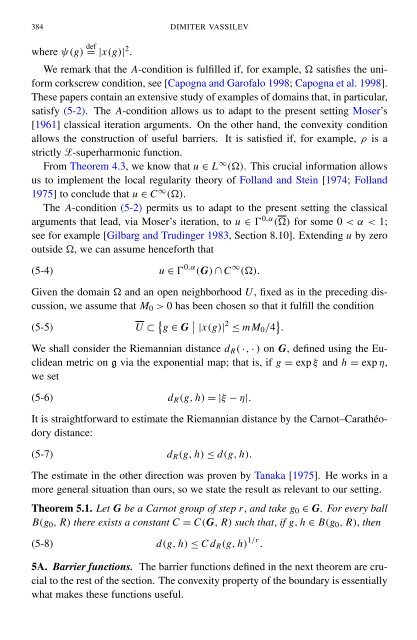Regularity near the characteristic boundary for sub-laplacian operators
Regularity near the characteristic boundary for sub-laplacian operators
Regularity near the characteristic boundary for sub-laplacian operators
Create successful ePaper yourself
Turn your PDF publications into a flip-book with our unique Google optimized e-Paper software.
384 DIMITER VASSILEV<br />
where ψ(g) def = |x(g)| 2 .<br />
We remark that <strong>the</strong> A-condition is fulfilled if, <strong>for</strong> example, satisfies <strong>the</strong> uni<strong>for</strong>m<br />
corkscrew condition, see [Capogna and Garofalo 1998; Capogna et al. 1998].<br />
These papers contain an extensive study of examples of domains that, in particular,<br />
satisfy (5-2). The A-condition allows us to adapt to <strong>the</strong> present setting Moser’s<br />
[1961] classical iteration arguments. On <strong>the</strong> o<strong>the</strong>r hand, <strong>the</strong> convexity condition<br />
allows <strong>the</strong> construction of useful barriers. It is satisfied if, <strong>for</strong> example, ρ is a<br />
strictly -superharmonic function.<br />
From Theorem 4.3, we know that u ∈ L ∞ (). This crucial in<strong>for</strong>mation allows<br />
us to implement <strong>the</strong> local regularity <strong>the</strong>ory of Folland and Stein [1974; Folland<br />
1975] to conclude that u ∈ C ∞ ().<br />
The A-condition (5-2) permits us to adapt to <strong>the</strong> present setting <strong>the</strong> classical<br />
arguments that lead, via Moser’s iteration, to u ∈ Ɣ 0,α () <strong>for</strong> some 0 < α < 1;<br />
see <strong>for</strong> example [Gilbarg and Trudinger 1983, Section 8.10]. Extending u by zero<br />
outside , we can assume hence<strong>for</strong>th that<br />
(5-4) u ∈ Ɣ 0,α (G) ∩ C ∞ ().<br />
Given <strong>the</strong> domain and an open neighborhood U, fixed as in <strong>the</strong> preceding discussion,<br />
we assume that M 0 > 0 has been chosen so that it fulfill <strong>the</strong> condition<br />
(5-5) U ⊂ { g ∈ G ∣ ∣ |x(g)| 2 ≤ m M 0 /4 } .<br />
We shall consider <strong>the</strong> Riemannian distance d R ( ·, · ) on G, defined using <strong>the</strong> Euclidean<br />
metric on g via <strong>the</strong> exponential map; that is, if g = exp ξ and h = exp η,<br />
we set<br />
(5-6) d R (g, h) = |ξ − η|.<br />
It is straight<strong>for</strong>ward to estimate <strong>the</strong> Riemannian distance by <strong>the</strong> Carnot–Carathéodory<br />
distance:<br />
(5-7) d R (g, h) ≤ d(g, h).<br />
The estimate in <strong>the</strong> o<strong>the</strong>r direction was proven by Tanaka [1975]. He works in a<br />
more general situation than ours, so we state <strong>the</strong> result as relevant to our setting.<br />
Theorem 5.1. Let G be a Carnot group of step r, and take g 0 ∈ G. For every ball<br />
B(g 0 , R) <strong>the</strong>re exists a constant C = C(G, R) such that, if g, h ∈ B(g 0 , R), <strong>the</strong>n<br />
(5-8) d(g, h) ≤ C d R (g, h) 1/r .<br />
5A. Barrier functions. The barrier functions defined in <strong>the</strong> next <strong>the</strong>orem are crucial<br />
to <strong>the</strong> rest of <strong>the</strong> section. The convexity property of <strong>the</strong> <strong>boundary</strong> is essentially<br />
what makes <strong>the</strong>se functions useful.
















